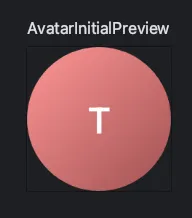import io.getstream.video.android.compose.ui.components.avatar.Avatar
@Composable
fun MyCustomAvatar(user: User) {
Avatar(
modifier = Modifier.size(56.dp),
imageUrl = user.imageUrl,
initials = user.name.initials(),
)
// ... rest of your code
}Avatar
In our Video SDK, we provide a few different avatar based components. The Avatar component is a Jetpack Compose utility component that renders an image or initials based on the user state. If the user has an image URL defined in their profile, the component renders the ImageAvatar component. Otherwise, it uses the InitialsAvatar component to show the user’s initials, based on the user name or id.
Let’s see how to use the component.
Usage
To add the Avatar component to your layout, you can use the Avatar composable function like this:
As mentioned, if the imageUrl is not null or empty, the component will try to render the image. Otherwise it will just show the user initials, like so:
| ImageAvatar | InitialsAvatar |
|---|---|
This component is very simple, but it allows different types of customization. Let’s explore them.
Handling Actions
The Avatar component exposes the following behavior customization:
public fun Avatar(
imageUrl: String?,
initials: String?,
onClick: (() -> Unit)? = null,
)imageUrl: While a part of the state, if the image exists, it’ll be rendered. Otherwise, the behavior of the component changes to render theinitials.initials: Used as a fallback for theimageUrlbeing empty or failing to load.onClick: Handler when the user clicks on the avatar.
You can simply pass these parameters when calling the Avatar component, to customize what date it renders and how it behaves when the user clicks on the item.
Customizing UI is much more complex and deep for the Avatar. Let’s explore it.
Customization
The Avatar allows the following customization options for its UI:
public fun Avatar(
modifier: Modifier = Modifier,
shape: Shape = VideoTheme.shapes.avatar,
textStyle: TextStyle = VideoTheme.typography.title3Bold,
contentScale: ContentScale = ContentScale.Crop,
previewPlaceholder: Int = LocalAvatarPreviewPlaceholder.current,
loadingPlaceholder: Int? = LocalAvatarLoadingPlaceholder.current,
contentDescription: String? = null,
initialsAvatarOffset: DpOffset = DpOffset(0.dp, 0.dp),
)modifier: Used for styling the base component. Helpful for defining thesizeof the component and adding extra decoration.shape: How the component is clipped. You can easily customize this component on a global SDK level, by changing theVideoTheme.shapes.avatarproperty ofStreamShapes. Alternatively, you can pass in a custom shape for each instance of theAvatarcomponent you call.textStyle: Defines the style of text used for theInitialsAvatar.contentScale: Used to define the scale type for theImageAvatar.previewPlaceholder: Renders a placeholder on Android Studio to support Compose Previews.loadingPlaceholder: Renders a placeholder image while theimageis loading.contentDescription: Helps define accessibility attributes for easier navigation.initialsAvatarOffset: Padding offset for theInitialsAvatar.
Using these parameters you can completely overhaul how the Avatar component looks and behaves. You can change the shape to be a square, squircle or a custom drawn shape, you can change its size, scale type and add placeholders.
On top of that, if you want to customize the ImageAvatar or InitialsAvatar components, you can use their respective composable functions, like so:
import io.getstream.video.android.compose.ui.components.avatar.Avatar
import io.getstream.video.android.compose.ui.components.avatar.ImageAvatar
import io.getstream.video.android.compose.ui.components.avatar.InitialsAvatar
@Composable
fun MyCustomAvatar(user: User) {
// If you want us to determine which avatar to render
Avatar(
modifier = Modifier.size(56.dp),
imageUrl = user.imageUrl,
initials = user.name.initials(),
)
// If your state and logic require an image avatar
ImageAvatar(
imageUrl = imageUrl,
modifier = Modifier.size(56.dp),
)
// If your users don't have images and you want to render their initials
InitialsAvatar(
initials = initials,
modifier = Modifier.size(56.dp),
textStyle = ... // custom text style
)
}UserAvatar
If you want to render an avatar based on the User instance, you can use the UserAvatar component, which displays an image or initials with an online indicator depending on the user’s information.
UserAvatar(
user = user, // StreamVideo.instance().user or participantState.initialUser,
isShowingOnlineIndicator = true,
onlineIndicatorAlignment = OnlineIndicatorAlignment.TopEnd
)This component is very simple as the Avatar component above and you’ll see the result below:

You can also customize with your own online indicator by implementing your own composable inside onlineIndicator parameter like so:
UserAvatar(
user = user,
onlineIndicator = {
Box(
modifier = Modifier.align(Alignment.TopEnd)
.size(12.dp)
.background(VideoTheme.colors.appBackground, CircleShape)
.padding(2.dp)
.background(VideoTheme.colors.infoAccent, CircleShape)
)
},
..
)Note that all of these components have several properties exposed in our VideoTheme, such as the initials text style, the color, shape and more.
Make sure to explore our VideoTheme guide to learn more.

